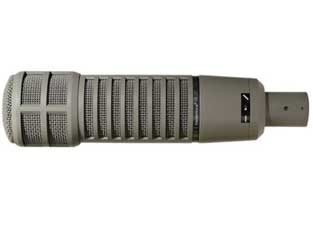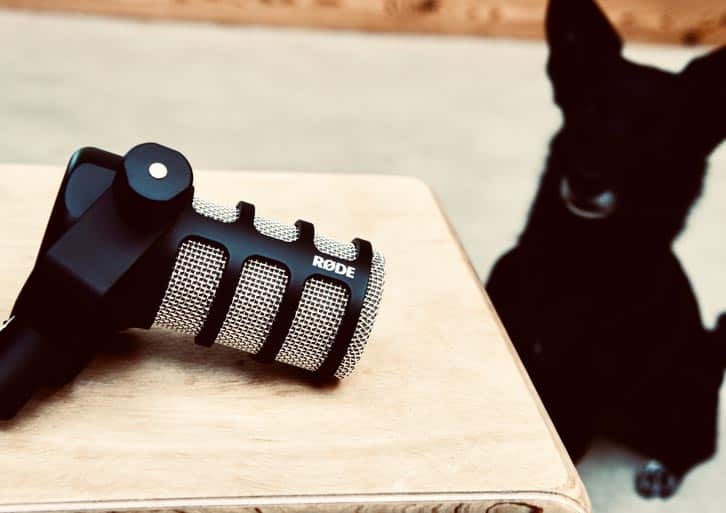Overview: Rode PodMic Review
Rode PodMic
OUR RATING:
4.5
(out of 5)
Specs
- Polar Pattern: Fixed Cardioid
- Frequency range: 50 Hz – 13 kHz
- Sensitivity: 1.60mV @ 94 dB SPL
- Impedance: 320Ω
- Weight: 937 grams
Pros
- Quality build
- Good sound on spoken word applications
- Affordable
Cons
- Sound might not be to your taste – has a consistent ‘radio voice’ color
- Hyped frequency response limits its use to spoken word applications
Bottom Line:
A quality dynamic mic purpose-built for the spoken word priced around $100.

Check Availability and Price in Your Region:
US and Canada
UK and Europe
Introducing the Rode PodMic
As a follow-up the Rode Podcaster (a USB dynamic mic) and the Rode Procaster (a sort of Electro-voice RE20 clone), Rode released the PodMic, a no-frills, dynamic broadcast mic at a very competitive price point. The PodMic targets podcasters on a budget.
We got our hands on this now very popular mic and tested it thoroughly to see how it sounds and how it compares to the competition.
See here for more on mics for podcasting and voice-over. For all of our mic reviews, see here. And here, for all of our audio gear reviews and tips.
Who is the Rode PodMic for?
The Rode PodMic is suited to podcasters and voice-over artists in search of an affordable, quality microphone.
PodMic does not require 48V phantom power to operate. It has a standard XLR connection and will require an audio interface to connect to a computer.
There is also a USB version of the PodMic. I cannot recommend the USB version, as I have not tried it out myself. In general, I am wary of USB mics. In most cases (except for the Blue Yeti X), the sound quality with a USB connection is significantly compromised.
Being a dynamic microphone, the PodMic is excellent at rejecting unwanted sound reflections and neighboring noise. In other words, you won’t need to record in an acoustically prepared room to get good results.
Who is the Rode PodMic NOT for?
For podcasters, voice-over artists, and broadcasters looking for a mic that will bring out the natural sound of your voice, the PodMic is probably not the best choice as it has a very produced, ‘radio-voice’ sound out-of-the-box.
The Rod PodMic is also not recommended for the following applications:
- Applications that require polar patterns other than cardioid
- Recording instruments, sung vocals, or other musical applications
Alternatives to the Rode PodMic
Electro-voice RE20
One of the best all-purpose dynamic mics available. A very popular choice among broadcasters.

Check Price:
Shure SM7B
Iconic, warm, full sound ideal for spoken word or sung vocals.

Check Price:
Shure MV7
Marketed as a budget version of the SM7B. Quality, detailed sound. Has both USB and XLR connections.

Check Price:
Blue Yeti X
Offers competitive sound quality with a USB connection. One of the very few decent sounding USB mics out there.

Check Price:
Build/Design

The Rode PodMic is a more affordable version of the Rode Procaster. Slimmed down with a swing mount design, the PodMic has a classic broadcast mic look.
The PodMic comes in white with a black grille, or (our preference) black with a silver grille.
The mic is, in every way, specialized for the spoken word. It has a built-in pop filter for reducing plosives, as well as an internal shockmount to reduce handling noise.
With an all-metal body and a stainless steel grille, it looks and feels very sturdy. The PodMic is compact, but it weighs a ton. Well, not a ton, but 937 grams. In comparison, the Shure SM7B, a sizeable mic, weighs 784 grams. It will definitely require a sturdy boom arm or stand. (Something like the Rode PSA1 boom arm would do.)
The PodMic has relatively high sensitivity (1.60mV @ 94 dB SPL). It doesn’t demand a large amount of gain and will work smoothly with most audio interfaces.
Sound
Rode PodMic Frequency Response Diagram

As with the build, the sound of the Rode PodMic is tailor-made for the spoken word. The frequency response is pre-tweaked with a high-pass filter to reduce city rumble (50-70 Hz), a warmth peak (100-150 Hz), a bump for lyric clarity (around 800 Hz), a presence peak (5-6 kHz), and a lot of air at the top (9-13 kHz) for a bright, modern sound.
Being a specialized broadcast mic, the hyped frequency response is great for an out-of-the-box ready sound requiring very little EQ to get going. But this hyped response has limitations. It won’t give you a natural, versatile result like higher end dynamic mics and it is limited to spoken word applications.

The PodMic has a large sweet spot in front of the mic in its fixed cardioid polar pattern. The off-axis response is very consistent, which allows you to not feel frozen in one position during recording sessions.
In other tests, the proximity effect was about normal for a dynamic mic – not overly pronounced but definitely present. The rejection of neighboring noise was also very good, as you would expect from a dynamic mic. The PodMic’s plosives (P and B sounds) are very controlled and sibilance (s sounds) sounds very natural.
Overall, in our tests, I found the sound to be somewhere between good to very good for broadcasting purposes. It is not a natural sound: it sounds like a dynamic mic used for broadcasting with a bit of modern brightness to it.
The PodMic lacks the fullness of something like the SM7B, or the natural warmth of the RE20, but it delivers at its price point.
Rode PodMic Testdrive
We used a Universal Audio Apollo Solo Interface recorded with Logic Pro X. To give an idea of the raw sound of this mic, we have resisted the urge to make any post-recording adjustments to the tracks. There is no EQ or compression applied to any of the audio clips here. We adjusted the gain from the audio interface to taste.
Full disclosure: We fully acknowledge that there is no one way to use a microphone. Mic placement, how you play or sing, not to mention EQ, compression, impedance, and preamp settings can all have dramatic effects on the final result.
Final Thoughts:
The Rode PodMic simply does what many start-up podcasters need it to do – deliver good broadcast sound at a low price. As a dynamic mic made for the spoken word that costs about the same price as a Shure SM58, it fills a gap in the market.
Critics might not like the hyped frequency response, but you’d be hard-pressed to find a better dynamic mic for the spoken word at this price.
Questions or Comments?
Join the discussion here on Facebook.